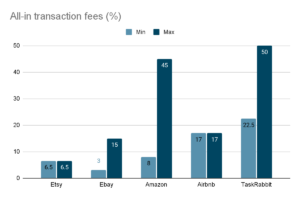Why are online marketplace fees so high?
Not so long ago, the usual process of buying something was arduous — you had to leave your home, travel to a store that you hoped had inventory in what you wanted, search the aisles, wait in line, pay at checkout, and lug the thing back home.
In the 1990s, the adoption of the internet made way for the first online marketplaces. They started as fringe operations with plenty of skeptics.
Listen and be open, but don’t let anybody tell you who you are. This was just one of the many stories telling us all the ways we were going to fail. Today, Amazon is one of the world’s most successful companies and has revolutionized two entirely different industries. pic.twitter.com/MgMsQHwqZl
— Jeff Bezos (@JeffBezos) October 11, 2021
Fast forward to today, and online marketplaces are omnipresent. What was once a painful process is now as easy as point-click-buy-deliver. However, online marketplaces do not offer a free lunch for buyers and sellers.

Chart sources: Etsy / Ebay / Amazon / Airbnb / TaskRabbit
Buyers accept high fees on goods bought from online marketplaces because they value lower listed prices and the difficult work done by these companies to aggregate high quality “inventory” to choose from. The equation is similar for services. Take TaskRabbit as an example — more than anything else, its exorbitant fee compensates TaskRabbit for the timely introduction of service provider and service seeker. After the initial transaction is completed, the buyer and seller may decide to transact again directly instead of through TaskRabbit’s app.
Sellers accept high fees so that they can bring new inventory to market more easily and expand their access to new markets. Online marketplaces can help sellers abstract away distribution details that are difficult and time-consuming, including some efforts that go into sales, marketing, and logistics.
How can web3 commerce disrupt online marketplaces?
1. Aggregation of inventory
Blockchains, the foundation of web3 commerce, create a general purpose infrastructure for the exchange of goods and services in one place. Sellers can list a variety of goods and services which can be purchased from a uniform, wallet style interface. You don’t need to pop back and forth between marketplaces if you don’t want to.
2. Aggregation of buyers
Blockchains come with a built-in set of buyers: the active users on the system. They may join for one type of purchase and stay for another.
3. Reputation management
Amazon was one of the first marketplaces to incorporate customer reviews in an effort to reduce fraud. Most marketplaces today give customers the ability to rate or review following their purchase. Blockchains can inform reputation both across historical transactions and across different contexts.
4. Reduced fees
Amortizing the costs of marketplace formation across many use cases, blockchains can lower the frictional costs to the buyer and seller.
Just as today we couldn’t imagine being subjected to the limitations of shopping only at brick-and-mortar stores, it will soon seem absurd that we were willing to pay such high fees to online marketplaces. At BlockApps, we are working to facilitate web3 commerce in real-world assets to solve this very problem. Stay tuned.





